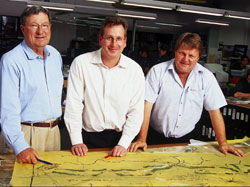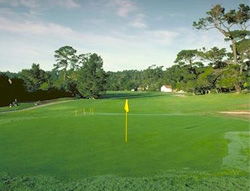How to design a golf course
We asked top course architect Tim Lobb to reveal some trade secrets on how golf courses are created

QUOTE:'After reading reviews of umpteen golf courses, often the designer or architect is revered for their skill in creating such a masterpiece. Can it really be that difficult to pop a few bunkers, a dogleg, pond here and there? Could the likes of Mackenzie, Colt, Hawtree, Braid, Steel, Tom Morris, Nicklaus et al possess some superior ability to design great golf holes? Or is it merely golf media hype?'
WHEN I was boy, growing up in Australia, I used to draw imaginary golf holes on scraps of paper. I’d dream up doglegs cutting through forests, par-3s over canyons and tee shots running along the oceanfront. I would spend hours thinking up what I thought were the greatest golf holes in the world. It wasn’t just because I loved playing golf. I had a fascination for landforms and the environment and was intrigued how this addictive sport of ours’ interacts with the natural world around us. That, to me, is still the essence of good golf course design – it’s about taking the existing natural terrain and features and creating a seamless transition into a golf course. It’s true that modern golf course design and construction has become a high-tech, global business, but the basic process of designing a golf course has changed little from the early days when the designers would stride out onto virgin territory with a handful of sticks and mark out where tees, bunkers and greens should be placed. | |
If you’ve ever been interested in how a golf course is designed, here’s a step-by-step guide to what happens: 1 Observing the site The first thing a designer does when presented with a golf course project is to go and observe the site. Of course, you can look at aerial photographs, maps, or even take a helicopter flight, and all this is useful. But the best way to get a feel for the land and really understand it, is to walk the site. The designer is looking at the landforms, the hills and the slopes and seeing how they all interact. I remember going to Turkey to visit the site at Carya Golf Club (due to open in November 2007) for the first time. It was incredibly exciting. It is such a fantastic piece of land, with rolling sand hills, vegetation and woodland close to the beach. It was clear that the seamless transition from natural environment to golf course that I was looking for would be possible and that the classic, heathland-style course that I wanted to create could become a reality. My partner Peter Thomson, who was very successful on healthland courses such as Sunningdale, thought this was an outstanding site – and we believe Carya is going to be very special indeed. 2 ‘Routing’ the course This means roughly laying out where the holes are going to go, a little bit like a road map. First decision is to locate where the clubhouse is to be positioned and from that it is possible to sketch out where the first and 18th holes, and perhaps the 9th and 10th holes, will go. On old Scottish links, the thin strips of coastal duneland necessitated a simple linear route with nine holes running along the coast one way (outward nine) and nine coming back the other way (inward nine). Even though at this stage we are creating a fairly basic course layout, the designer is deciding whether each hole is a par-3, par-4 or par-5. Often we will be looking for areas of special significance – a stream, large tree or rocky outcrop, for example, as these may determine a specific feature of the hole. | |
Think of a course like Pebble Beach where Phil Mickelson recently won the AT& T Pro-Am on the PGA Tour. There are two distinct areas – the inland holes and the coastal holes. The cliffs and oceanside terrain, in particular, have been used to maximum effect to create some of the most outstanding and memorable holes in golf.
This is where the detailed work starts as we are planning the golf course features for each individual hole and working out the shot-by-shot strategy. This means positioning the tee locations, pin-pointing fairway bunkers and locations of greens and deciding where greenside bunkers and defences will go. Many believe that designers are instinctively evil conspirators who try to trick-up holes by thinking only of where the back tees are going to go, leaving the average golfer with impossible challenges. That’s not good golf course design. The ideal scenario is that if a pro, 12-handicapper and 24-handicapper were to tee off from their respective tees, they would all find themselves in a similar position on the fairway. Mind you, they should all face different driving challenges to suit their skill level – the good golfer needs to be challenged with a little more angle from the tee to test his shot-making skills, whereas the higher handicapper should be given a more straightforward view. So it really is possible to create a course that the average player can enjoy yet it is still an excellent challenge for Tour players.
This is the most demanding and detailed aspect of golf course design. The real skill to designing the shape of the land – and I think the best designers possess this as an instinctive ability – is to think three- dimensionally, but draw in two dimensions. Imagine being asked to draw a picture in your mind in great detail – it’s not easy. You have to consider the view of the golfer and ensure that your design of the shape of the land really does allow them to see what you want them to see. You have to think about how different elements within the landform relate to each other, so the holes really do flow naturally through the landscape. It’s a bit like building up a painting, layer by layer. But it’s not just the aesthetics and visual elements. The designer has to consider more practical elements like effective drainage – you don’t want puddles on your fairways and greens every time it rains. The green ‘complexes’ are essential as these create a lot of interest for a course. While you want slopes and undulations, you don’t want to over-do it and create impossible putts. The initial design is still done by hand, but thanks to computer-aided design (CAD), these designs can now be digitised to create superb three-dimensional interpretations.
Like most things in life, nothing ever goes perfectly to plan. So the designer has to be adaptable, flexible and be prepared to modify his design as the course is being constructed. As the holes begin to reveal themselves, the designer may see things that weren’t obvious during the first observations. They may change their mind on certain aspects of the design or see something that doesn’t sit in harmony with the environment. For example, at one course I designed at Linna in Scandinavia, we had to move a green forward from where it was originally positioned because we unearthed a rocky outcrop. I thought it would make an excellent architectural and completely natural feature at the back of the green, so we moved the green forward. It wasn’t in my original design, but it enhanced the hole, in my view. Having spent my youth designing imaginary golf holes, I feel very privileged to have fulfilled a dream and become a professional golf course designer. However, with the enjoyment of my job comes a great responsibility to ensure that we always work in harmony with the natural environment. The best golf courses in the world are also the most natural.
|




